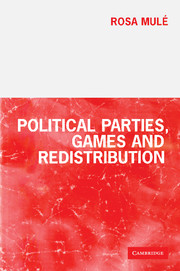Book contents
- Frontmatter
- Contents
- List of figures
- List of tables
- Acknowledgments
- Introduction
- 1 Political parties, games and income redistribution
- 2 Opposition effects, blackmail and u-turns under Pierre Elliot Trudeau
- 3 The arithmetics of politics under Margaret Thatcher
- 4 Right-wing ascendency, pivotal players and asymmetric power under Bob Hawke
- 5 The demise of the federal social safety net under Clinton
- 6 Conclusions
- Technical addendum
- Bibliography
- Index
2 - Opposition effects, blackmail and u-turns under Pierre Elliot Trudeau
Published online by Cambridge University Press: 22 September 2009
- Frontmatter
- Contents
- List of figures
- List of tables
- Acknowledgments
- Introduction
- 1 Political parties, games and income redistribution
- 2 Opposition effects, blackmail and u-turns under Pierre Elliot Trudeau
- 3 The arithmetics of politics under Margaret Thatcher
- 4 Right-wing ascendency, pivotal players and asymmetric power under Bob Hawke
- 5 The demise of the federal social safety net under Clinton
- 6 Conclusions
- Technical addendum
- Bibliography
- Index
Summary
POLITICAL BACKGROUND
This chapter explores the politics of income redistribution in Canada under the Liberal government of Pierre Elliot Trudeau. During his long-lasting premiership (1968–1984) Trudeau first expanded and then contracted social security benefits by redesigning entitlement and eligibility rules. This u-turn offers an excellent case study to explore how interdependent strategic action impinges on transfer programmes.
Social security provisions in North America were introduced late compared to other Western countries, and both Canada and the US are considered international laggards in welfare state expansion (Kudrle and Marmor, 1981; Myles and Pierson, 1997). However, the similarities between these two countries should not be exaggerated. For one thing, since the mid 1960s Canada has consistently offered more public support for families and caregiving than has the US (O'Connor, Orloff and Shaver, 1998; Osberg, Erksoy and Phipps, 1997). Between 1965 and 1975 new programmes were set up, the scope of existing social insurance schemes was extended, and social transfer payments were made more generous. Contributory unemployment insurance also covered the dependents of married claimants (Guest, 1997). For the unemployed without insurance coverage the government initiated the Canada Assistance Plan (CAP), which provided a guaranteed safety net for all persons in need, including Native Canadians, who earlier had been excluded from some provincial programmes.
In 1965 Pearson, then Liberal Prime Minister, had established a Special Planning Secretariat to coordinate antipoverty programmes and a federal–provincial conference to discuss the problem.
- Type
- Chapter
- Information
- Political Parties, Games and Redistribution , pp. 52 - 81Publisher: Cambridge University PressPrint publication year: 2001



